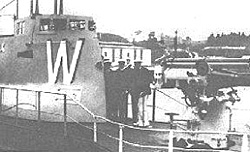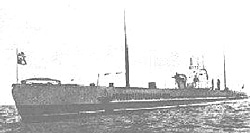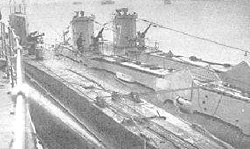
WILK in Gdynia before the war
Specifications for WILK class:
Length: 78.5 m
Beam: 5.9 m
Draft: 4.2 m
Displacement: 980/1248 t.
Power: [diesel] 2 x 900 shp = 1800 shp
Power: [electric] 2 x 600 shp = 1200 shp
Speed: [diesel] 14.5 knots
Speed: [electric] 9.5 knots
Tubes: Four forward 21.7”

Tubes: Two mid-ship 21.7” in a rotating mount
Tubes: [Ten torpedoes including four reloads]
Deck guns: Single 100 mm
AA guns: One twin mount 13.2 mm machine gun
Depth of dive: 80 m
Crew: 54 [5 officers, 49 men]
Mines: 40 MRK. SM 5
WILK departing Gydnia on patrol
ORP RYS [Lynx]
Built by: Chantiers de La Noire, Nantes, France
Type: WILK class
Design: French modified SAPHIR class with Polish specifications
Keel laid: 28 May 1927
Launched: 22 April 1929
Commissioned: 2 August 1931
Arrived in Poland: 14 August 1931
Decommissioned: September 1953 [scrapped 1956]
 The first skipper of RYS was Kapitan Marynarki [Lt. Cdr.] Edward Szystowski. First wartime skipper was Komondor Podporucznik [Cdr.] Aleksander Grochowski [took command May 1933].
The first skipper of RYS was Kapitan Marynarki [Lt. Cdr.] Edward Szystowski. First wartime skipper was Komondor Podporucznik [Cdr.] Aleksander Grochowski [took command May 1933].
RYS arriving Gydnia
In August 1931 RYS arrived into the port of Gydnia to much fanfare and celebration for being the first submarine of the Polish Navy. After waiting four years for the completion of the sub, the Poles were disappointed with the performance of this sub. The fuel tanks were prone to leaking, the engines were noisy and the minelaying systems unreliable. In January 1933 RYS returned to France for repairs. In 1935 & 1936 RYS visited foreign ports in the Baltic and carried out training with its sister subs. In April 1936 while in port a battery exploded injuring 13 sailors.
At the start of the war on 1 September 1939, RYS took on 20 mines and 10 torpedoes and according to PLAN WOREK [sack], proceeded to its patrol area in Danzig Bay. All of the Polish submarines were ordered to follow International Law prohibiting attacking unarmed ships without warning. They were also ordered not to lay mines as yet. RYS spotted two German destroyers while on the way to their patrol sector, but could not get into an attack position. On Sept. 3, RYS fired two torpedoes at a periscope that was spotted, with no result.
The same day, RYS was attacked by German planes causing damage to the fuel tanks resulting in fuel leakage. The next day RYS was constantly attacked, as the fuel gave away her position, receiving minor damage. At dusk, RYS was forced to surface for air and to recharge batteries. While on the surface, RYS engaged a German E-boat with the deck guns. The E-boat withdrew with no damage to either boat. The C.O. decided to make for Gydnia harbor before dawn on Sept. 5. German control of the air forced RYS to remain partially submerged with the conning tower camouflaged. On Sept. 7, RYS left port to its patrol sector with orders to lay mines. While laying its mines, RYS was depth charged causing the fuel tanks to leak again. RYS continued to patrol its sector reporting ship movements, but carried out no attacks. From Sept. 12 to Sept. 17, RYS patrolled the northern Baltic near Gotland.
After learning Russia attacked Poland and with the fuel tanks leaking, the C.O. sailed to Sweden to attempt repairs and break out to England. After arriving in Stavans, Sweden, it was found repairs could not be made in the next 24 hours and the RYS and crew were interned.
RYS was returned to Poland in November 1945 and served in the Polish Navy until 1953.
ORP ZBIK [Bobcat]
Built by: Chartiers Naval Francais, Caen, France
Type: WILK class
Design: Modified French SAPHIR class with Polish specifications
Keel laid: 1927
Launched: 14 June 1930
Commissioned: 20 Feb. 1932
Arrived in Poland: 1 May 1932
Decommissioned: Sept. 1953, scrapped 1956
First skipper of the ZBIK was Kpt. Mar. [LCdr] Eugeniusz Plawski and the first wartime skipper of ZBIK was Kdr. Ppor. Michal Zebrowski [took command July 1938].
On 1 September 1939, when ZBIK proceeded to its patrol area in the Baltic, ZBIK received orders to lay its mines near the Hel peninsula. On 7 September, while on the surface, ZBIK was attacked by a U-boat [U-23, CO Werner Winter?] which launched a torpedo. The torpedo exploded about 200m from ZBIK. The ZBIK made an emergency dive, escaping any further attack.
On 9 September ZBIK laid its mines. Later on 1 October, the German minesweeper M-85 struck a mine and sunk with a loss of 24 men while attempting to clear ZBIK’s mines.
On 14 September ZBIK received permission to breakout for England. While on its way to the Danish Straits ZBIK encountered a severe storm, causing damage to the main hatch. Water reached the batteries causing chlorine gas. Being unable to submerge safely, the C.O. decided to sail to Sweden. ZBIK arrived at Stavans, Sweden on 25 September and was interned.
ZBIK returned to Poland in October 1945, where it served in the new Polish Navy until 1953. While ZBIK, along with RYS and SEP, were interned, the Polish Naval Command ordered the crews to remain with their subs. With the tacit approval of the Swedish government, the Poles were able to repair and maintain the subs in the hope the military or political situation would change. After the invasion of Norway by Germany, Polish Naval Command ordered the subs to prepare to escape for England in the event Sweden was attacked. These orders remained in effect until December 1944 when Polish Naval Command evacuated most of the officers and non-commissioned officers to England.
ORP WILK [Wolf]
 Built by: Chartiers et Ateliers Augustin Normand, La Haure, France
Built by: Chartiers et Ateliers Augustin Normand, La Haure, France
Type: WILK Class
Keel laid: 1927
Launched: 12 April 1929
Commissioned: 31 October 1931
Arrived in Poland: 23 November 1931
Decommissioned: by Poland and handed over to British 28 September 1946
Towed to Poland: June 1951, scrapped October 1952?
WILK with DZIK & SOKOL after the war
The 1st C.O. of WILK was Kpt. Mar. [LCdr] Aleksander Mohuczy.
The first wartime skipper was Kpt. Mar. Boguslaw Krawczyk [Also the first Pole to be awarded the awarded the British DSO], later was awarded the Virtuti Militari, Poland’s highest military decoration. Three wartime patrols commanded by Kpt. Mar. B. Karnicki. Last wartime skipper was Kpt. Mar. Brunon Jablonski.
On September 1, 1939 WILK proceeded to its area of operations, which was well within Danzig Bay. WILK spotted a German destroyer on Sept. 2, but was unable to get into attack position after being bombed from the air by Luftwaffe planes. The bombing caused damage to the fuel tanks, which began to leak. [A constant problem for this type submarine.] Despite the fuel leaks WILK laid its mines on Sept. 3.
On Sept.5 WILK was depth charged for hours, while in silent mode on the bottom, causing more damage to the fuel tanks. Thirty minutes after the depth charges stopped the air became almost unbreathable and the C.O. decided to surface. The C.O. ordered the crew to prepare for surface action. Upon surfacing, the C.O. was surprised to see no other ships in the area. Apparently the fuel leaking from WILK convinced the Germans that they sunk or critically damaged the sub. WILK then sailed north towards Sweden to find a quiet area to make any repairs they could while at sea.
On Sept. 10, the C.O. figured the sub had only ten days of fuel remaining. The next day WILK received specific permission to breakout to England. On Sept. 14, WILK made its way on the surface through the Danish Straits without incident. WILK arrived at Rosyth, Scotland on Sept. 20. After refueling, WILK was ordered to Scapa Flow the next day. As WILK entered the British Navy’s Home Fleet base, the crew was shocked to see the crew of every Royal Navy ship on deck, cheering the WILK as they passed.
ORP WILK with the Royal Navy
WILK underwent repairs and refitting at Dundee, Scotland during October and November 1939. On 23 November 1939, WILK was assigned to Second Submarine Flotilla based in Dundee. In December 1939 WILK carried out two uneventful patrols off the southern coast of Norway. During these patrols WILK was plagued by frequent mechanical breakdowns. It was decided that WILK was to be dry docked for a major refit. The refit was not completed until June 1940. During this time the C.O., Kpt. Mar. Krawczyk was promoted to Kdr. Ppor. [Cmdr] and the second in command, Por. Mar. Karnicki was promoted to Kpt. Mar. [LCdr].
WILK’s third patrol was its most eventful, although what actually occurred is not totally clear. On this patrol and the following two patrols WILK was commanded by the second officer, Kpt. Mar. Karnicki. The usual skipper was sent on a mission to Sweden to check on the interned Polish submarines and their crews. What is clear about this patrol is that on the night of 20/21 June 1941, WILK collided with something. The crew claimed that while on the surface around midnight a lookout reported a small ship 300 meters away 10 degrees port.
The watch commander decided the ship was too close to fire torpedoes, turned to ram the ship, recognized as a German U-boat. The watch commander stated that the U-boat was attempting an emergency dive when WILK’s bow struck the U-boat in front of the deck gun as the deck had slipped under the water & the conning tower was about to submerge. The position of the collision was reported to the Royal Navy [56°50 N 03°37 E], which sent destroyers to search for signs of a sunk or damaged U-boat but nothing was found.
WILK limped back to Rosyth with a top speed of 3 knots, arriving on 25 June. The damage was not as severe as first thought. Half the blades on the starboard propeller were gone and only one blade remained on the port propeller. The bow was only slightly damaged but showed WILK had hit something. The British Admiralty commended the WILK for sinking a U-boat, but ordered the crew not to discuss the incident with anyone.
After the war, many authors have written many theories as to what actually occurred. Some authors contend that the submarine sunk was the U-122. Others write that it was the Dutch submarine 0-13, which was lost around that time and area. Still others write that a surface wreck, rocks, a mud bank or an underwater mine explosion caused the damage! Possibly the SHARKHUNTER’s archives or one of our readers have information on this incident.
- EDITOR NOTE – U-122 was lost to unknown causes in the North Sea on 21 June 1940.
After repairs, WILK began its fourth patrol on 10 July 1940, near Lister, Norway. During this patrol WILK was attacked from the air, escaping with no damage. The next day WILK fired two torpedoes at a tanker with no result. On WILK’s next three patrols between August and October 1940, the sub suffered numerous engine problems due to age and the lack of spare parts. After two patrols, one in November 1940 and one in January 1941, it was decided to place WILK into a training squadron where she remained for the duration of the war. Although no longer in combat, WILK trained new submariners and provided a veteran officer and crew cadre for three other Polish crewed submarines, ORP JASTRZAB, ORP SOKOL, and ORP DZIK.
All pictures courtesy of polishnavy.prv.pl
Once again, excellent article DAVID. Many thanks. To our other Members, we would enjoy your research articles. Make sure they are accurate and if possible, include photos. Thanks in advance.
Back to KTB # 176 Table of Contents
Back to KTB List of Issues
Back to MagWeb Master Magazine List
© Copyright 2004 by Harry Cooper, Sharkhunters International, Inc.
This article appears in MagWeb.com (Magazine Web) on the Internet World Wide Web. Other articles from military history and related magazines are available at http://www.magweb.com
Join Sharkhunters International, Inc.: PO Box 1539, Hernando, FL 34442, ph: 352-637-2917, fax: 352-637-6289, www.sharkhunters.com
